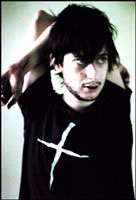Counterculture
John Cooper pores over Star Culture, a diverse collection of interviews from pioneer style journal Dazed and Confused

In the early 1990s Rolling Stone magazine published a collection of its finest extracts. This was not the Rolling Stone of today, which focuses on tired, burnt-out rock stars who have had their creative day. It was gonzo greats such as Hunter Thompson, carving up Nevada in search of the American Dream.
Since 1993 Dazed and Confused has been blazing its own trail in the style mag world. It has pioneered a course where commercial considerations are put on the back burner, eschewed in favour of innovative subject matter and inspired graphic design. Star Culture features a diverse range of interviews – with all sorts of celebrities from “radical intellectual” Noam Chomsky to filmmaker and writer Harmony Korine, who has brought a disaffected, nihilistic skatepunk style to US independent films in the shape of his films Kids and Gummo.
Many of the interviewees are willing to open up, revealing controversial elements of their character. Björk shows how cynical she is about celebrity when talking to Jefferson Hack: “80 per cent of my public image is bollocks, but at least 20 per cent is not that far from the truth.” On a similar theme, Chomsky theorises about the US drug war, accusing US banks of laundering Colombian drug money, talking about the double standards of US drug arrests, concluding that the drug war is “to criminalise and get rid of the black population.”
Star Culture is in your face, provocative journalism. There are several instances when two celebrities interview themselves: Ice T and George Clinton, icons of 1990s hip hop and 1970s glam funk, talk about fan worship. The climax of this discussion has Clinton revealing how a groupie tried to seduce him by flashing a tattoo below the bikini line that was dedicated explicitly to him. Other times this can be tedious: Björk interviews one of her heroes – composer Stockhausen – but they sound like a couple of anoraks when they talk about music. Slightly better is a tête à tête between Irvine Welsh and Iggy Pop, but you get the feeling most of these interviews are a couple of friends having a self-congratulatory chat into a dictaphone.
Simon Price has a better stab at an interview when he talks to The Beastie Boys, grilling Adam Yauch about Buddhism: “Buddhism is one of the three main destinations for bewildered rock stars. The other two are rehab and psychiatric treatment.”
Star Culture is also not afraid to go out on a limb – talking to writer Terry Southern, who tells how he was shafted by Peter Fonda and Dennis Hopper on Easy Rider, you can’t help but feel respect for a magazine that has such a ballsy desire to make up its own rules. Having said that, ageing rock stars figure prominently – Iggy Pop, Lou Reed and Keith Richards all put in an appearance – and you are instantly reminded of the old rockers that Rolling Stone is so obsessed with. Do today’s young beautiful people really care about these dinosaurs?
All in all, Star Culture is hard to fault. The variety of content – from extreme performance artists to leftfield writers – is entertaining and unusual. And it all comes in a slick package. Designer Gareth Hague of Alias has created a clean style, with title pages that are sometimes hard to read but are original – a hard task for a graphic designer in this day and age. In 20 years time, Star Culture will be a reminder that some style magazines in the 1990s where prepared to experiment, straying from the predictable path that seems to suffocate so many of their competitors.
Star Culture, Collected Interviews from Dazed & Confused magazine, edited by Mark Sanders and Jefferson Hack, is published by Phaidon on 10 July, priced £25
-
Post a comment



